#polychaete worms
Explore tagged Tumblr posts
Text
Uncharismatic Fact of the Day
When decorating for the holidays, why not ask the decorator worm to help? These worms are named both for their beautiful irridescent 'plumage' and the tunnels they construct benath the ocean floor, which are often lined with bits of algae, coral, and shells. These tubes can be up to .9 m (3 ft), and are used by the worms to hide from predators.

(Image: A decorator worm (Diopatra cuprea) by Jim Aguilar)
#decorator worm#Eunicida#Onuphidae#polychaete worms#segmented worms#annelids#worms#invertebrates#uncharismatic facts
171 notes
·
View notes
Text
Mentioned briefly in my last post, but I do in fact have holographic worm stickers for sale now.

There’s far more to the world of Annelida than the humble nightcrawlers you find in your yard; many species are found in marine environments, where they take such varied forms as the fearsome bobbit worm or the ethereal tomopteris. Here I’ve rendered a ragworm (family Nerididae); a sort of polychaete (bristle worm) found in benthic marine (and occasionally freshwater) environments the world over.
Some cool facts to win you over:
1. The largest ragworm in the world is the king ragworm (Alitta virens), which ready achieves lengths of 4 ft/120 cm.
2. Ragworms are an important part of the live sea-bait industry. Unfortunately that also means they have been harvested so extensively in some areas that their populations are threatened.
3. Ragworms reproduce through a bizarre process called epitoky, in which the benthic worm either transforms into a free-swimming reproductive morph, or buds off several free swimming sex-clones to party in the world above. Either way, it will be the final act of the animal’s life.
4. Ragworms, like bobbit worms, have large, eversible mandibles in their pharynx that they extrude to give a nasty bite.
5. On the topic of ragworm jaws, the material they are made of is very strong and lightweight, despite lacking the calcium mineralization of most other animals with hard body structures. There is some research investigating its structure for aerospace engineering applications!
538 notes
·
View notes
Text

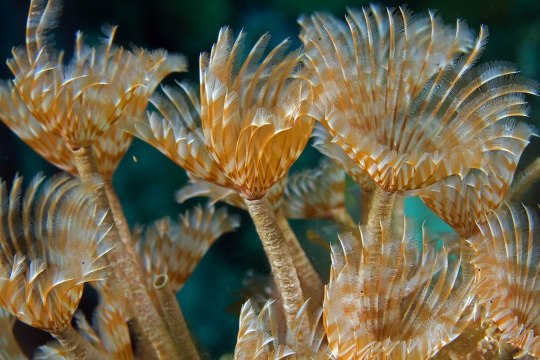
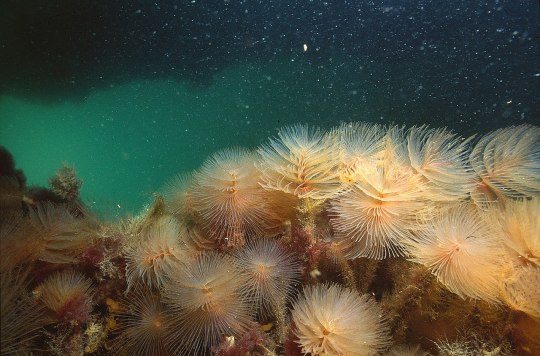
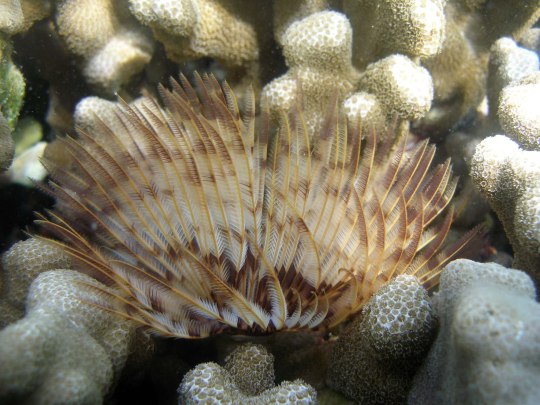



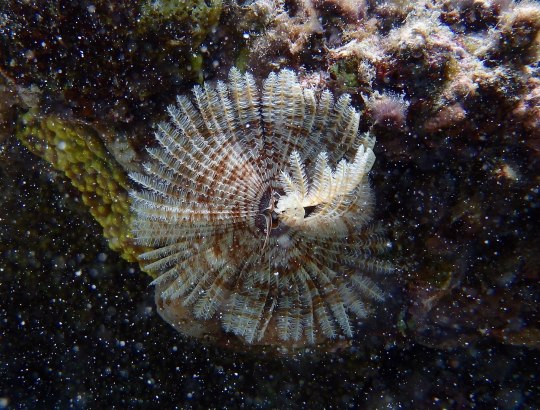

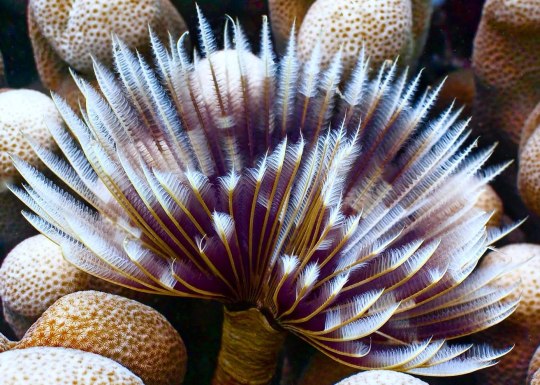

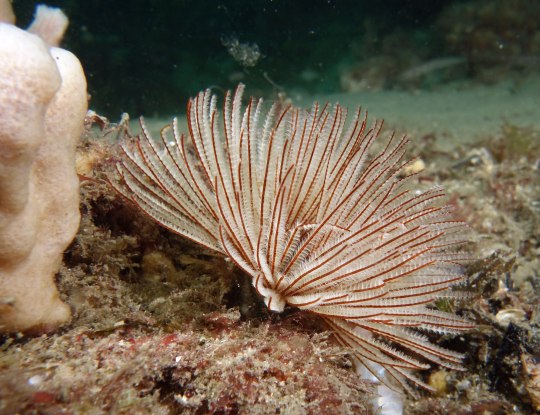



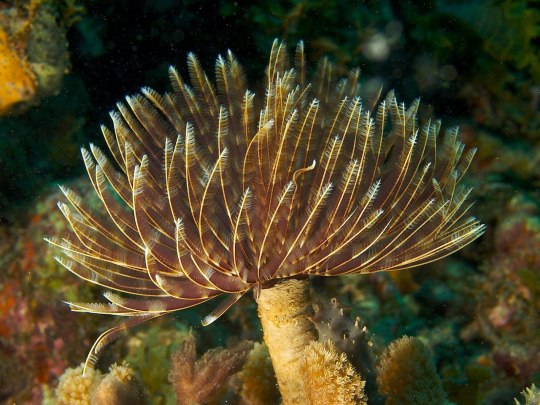
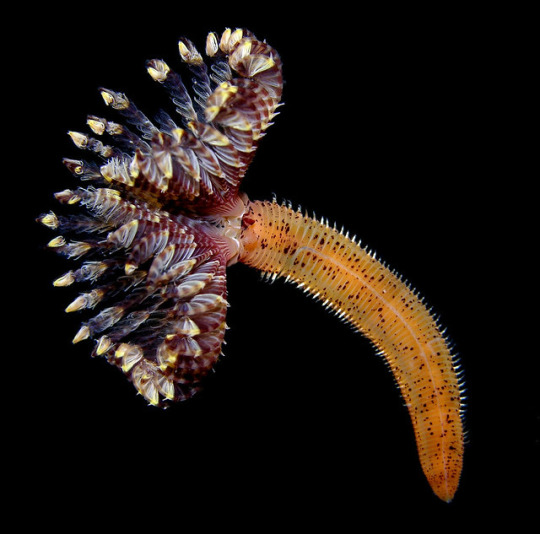


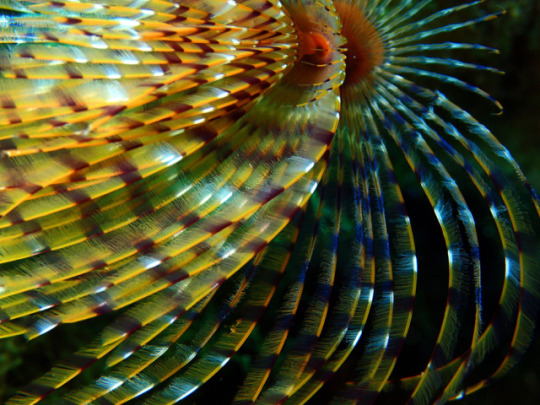

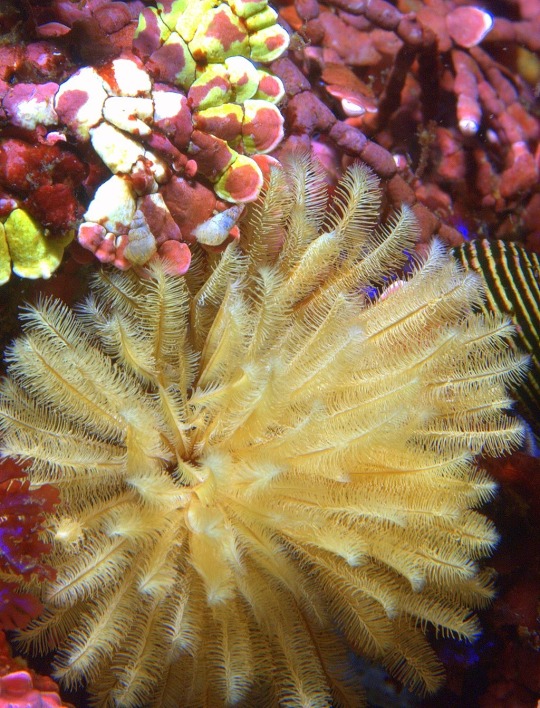
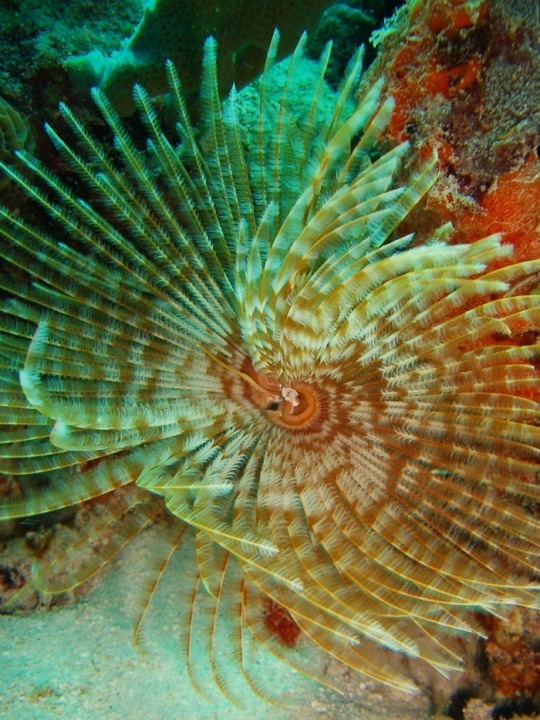

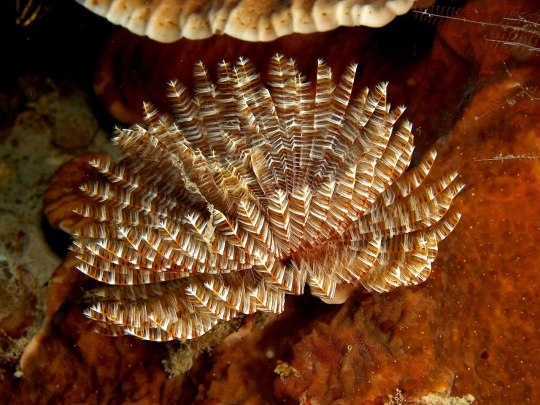


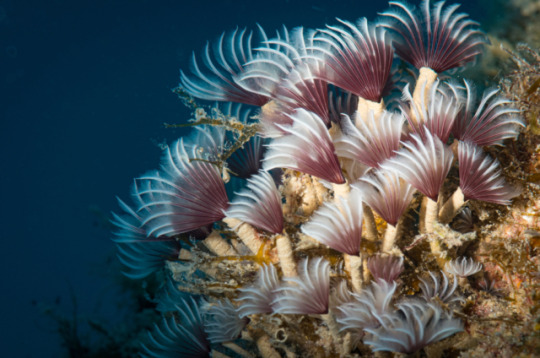

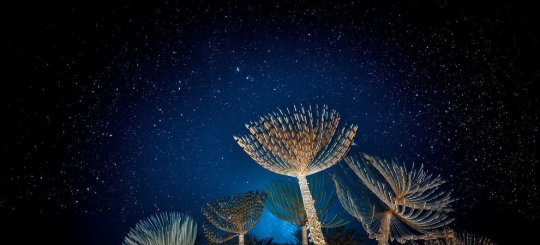
Сабеллиды – семейство сидячих многощетинковых червей, распространенных в донных сообществах всех океанов. К сидячему образу жизни сабеллиды приходят не сразу. На стадии личинки червь безмятежно дрейфует в океанических водах. Взрослые особи живут в песке или в илистом грунте мелководной зоны. Сабеллиды - социальные животные, образующие большие колонии в тех местах, где достаточно пищи. На переднем конце тела сабеллид расположена пара перистых, покрытых ресничным эпителием пальп. С помощью этих перьеобразных щупальцев-жабр черви собирают из толщи воды и с поверхности грунта частицы, которые затем используют в пищу или для построения трубки. Кусочки грунта они смешивают со слизью и строят трубки из материала, напоминающего пергамент. Длина трубок в зависимости от вида колеблется от 2 до 10 см. Пальпы одновременно служат и органами дыхания, так как через их поверхность осуществляется интенсивный газообмен. Кроны этих щупальцев выступают из торчащих на дне трубок подобно лепесткам великолепных цветов. Однако при малейшем движении воды «цветы» мгновенно втягиваются, оставляя на поверхности лишь низкие серые «пеньки». Окраска щупальцев-жабр червей разнообразная, но чаще всего это бежевые, желтые, коричневые, черные, темно-красные, лиловые и белые цвета. Зоологи обнаружили более 10 тысяч видов этих животных.
Sabellidae are a family of sessile polychaete worms common in benthic communities of all oceans. Sabellids do not immediately adopt a sedentary lifestyle. At the larval stage, the worm drifts serenely in ocean waters. Adults live in sand or muddy soil in the shallow water zone. Sabellids are social animals, forming large colonies in places where there is enough food. At the anterior end of the sabellid body there is a pair of feathery palps covered with ciliated epithelium. With the help of these feather-like tentacles-gills, the worms collect particles from the water column and from the surface of the soil, which are then used for food or to build a tube.They mix pieces of soil with mucus and build tubes from a material resembling parchment. The length of the tubes, depending on the type, ranges from 2 to 10 cm. The palps also serve as respiratory organs, since intensive gas exchange occurs through their surface. The crowns of these tentacles protrude from tubes protruding from the bottom like the petals of magnificent flowers. However, at the slightest movement of water, the “flowers” are instantly retracted, leaving only low gray “stumps” on the surface. The color of the tentacles-gills of worms is varied, but most often they are beige, yellow, brown, black, dark red, purple and white. Zoologists have discovered more than 10 thousand species of these animals.
Источник:https://m.vk.com/video-177833227_456240992?list=f6ce210ae901f2fd35&from=wall-3724862_1674, /ru.wikipedia.org/wiki/Сабеллиды, /vk.com/volgbioclub //www.gismeteo.ru/news/animals/raspushit-perya-kto-takie-sabellidy-i-zachem-im-nuzhny-pjoryshki/, /muzei-kholmsk.shl.muzkult.ru/Sabellids, //pofoto.club/32013-sabellidy.html, /zoogalaktika.ru/photos/invertebrata/annelida/polychaeta.
#fauna#nature#video#animal video#marine life#marine biology#aquatic animals#benthic#polychaete worms#Sabellidae#ocean#sand#corals#plankton#animal photography#nature aesthetic#видео#природа#фауна#бентосные#многощетинковые черви#полихеты#Сабеллиды#песо��#кораллы#планктон
269 notes
·
View notes
Text

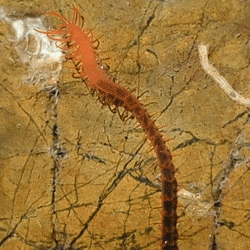
14/09/23 - Syllidae sp.
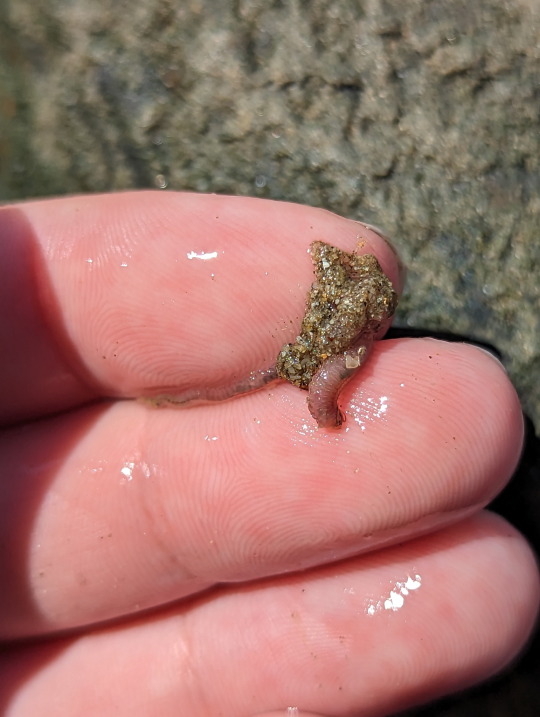
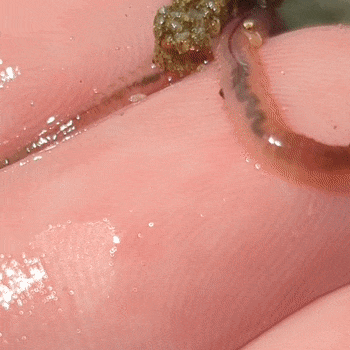
14/09/23 - Annelida sp.

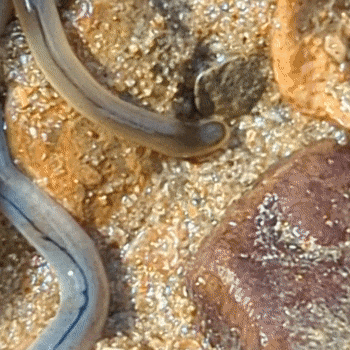
14/09/23 - Unidentified
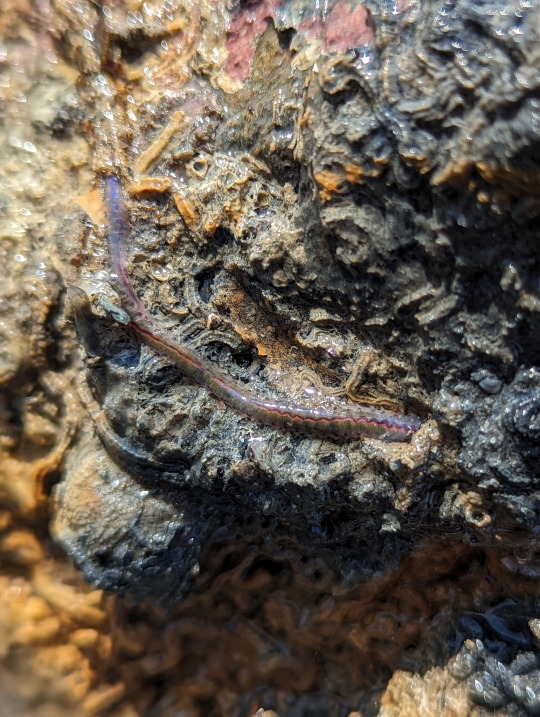
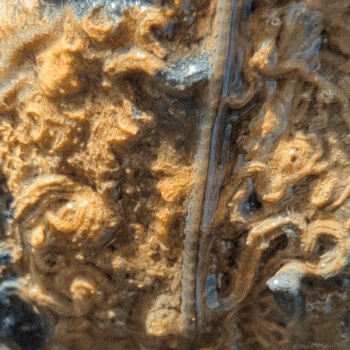
14/09/23 - Annelida sp.

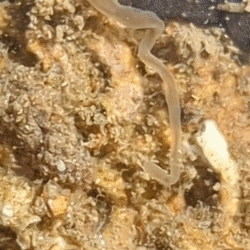
14/09/23 - Unidentified
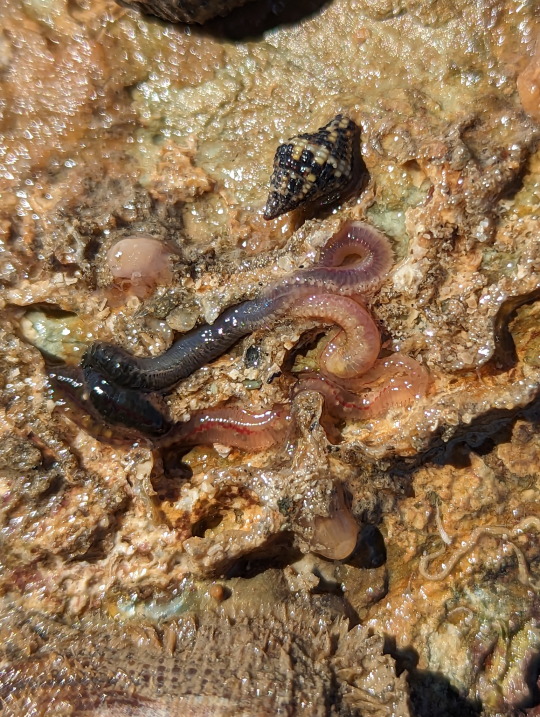
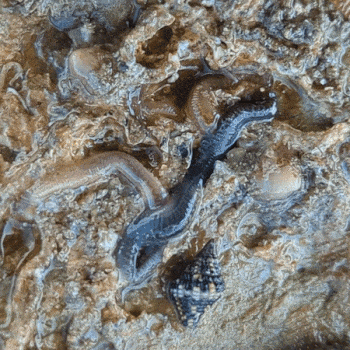
14/09/23 - Annelida sp.
Marine worms collected from tidepools
14/09/23
QLD:CQC - Yeppoon, tidepools
#Syllidae#unidentified#Polychaeta#Polychaete Worms#Annelida#Segmented Worms#Errantia#bristle worms#worms#gifs
101 notes
·
View notes
Text
Feather Duster Worm sketch

6 notes
·
View notes
Text

YEAR OF THE DRAGON
6K notes
·
View notes
Text


Photos thanks to Oceana & Scuba!
#indo pacific#carribean#christmas tree worm#polychaete#polychaete worm#annelida#marine invertebrates#marine animals#marine biology#pleistoannelida#sedentaria#serpulidae#animal polls#poll blog#my polls#animals#polls#tumblr polls#sea creatures#marine life
290 notes
·
View notes
Text
Wet Beast Wednesday: Christmas tree worm
Merry Christmas from the ocean! For this festive occasion, I’ve chosen to cover an animal that certainly has the spirit of the season. The Christmas tree worm is the person who keeps their Christmas lights up all year of the sea and today we’re going to see what makes them tick.
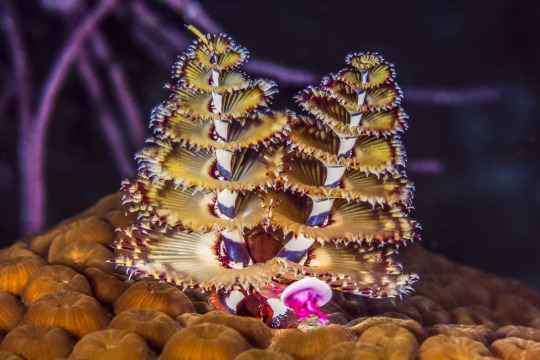
(Image: the crown of a Christmas tree worm. It appears as two stalks emerging from amongst coral polyps. Small feathery, appendages emerge from the stalks in a spiral formation going up them. They are yellow, with brown tips. A smaller, round structure is near the base of the trees. End ID)
The Christmas tree worm (Spirobranchus giganteus) is a polychaete worm of the tube-building fan worm clade Sabellida. While they are called giganteus, that’s only relative to other fan worms as they max out at about 3.8 cm (1.5 in) long. Being tube worms, they build a tube of calcium carbonate that they live in. This tube provides protection for the worm, who can retreat into it if threatened by predators. Polychaetes are defined by the paired bristle-like chaetes on each body segment, which are often used for locomotion. Tube worms like the Christmas tree worm lack these kind of locomotive appendages as they spend their entire lives in their tubes.

I couldn't find a full-body picture of a Christmas tree worm outside of its tube, so this is the best you get. (Image: Serpula vermicularis, a member of the same family of tube worms as the Christmas tree worm, removed from its tube. It is a short, segmented worm with a plug on a stalk and a crown consisting of long, feathery tentacles arranged differently than those of a Christmas tree worm. End ID)
The feature that gives these worms their common name is a pair of feathery, spiraling structures that emerge from the head and look quite a bit like tiny, colorful fir trees. These structures, called crowns, are heavily modified version of mouth appendages called prostomial palps. The feathery bits are tentacles called radioles. The crown is usually the only part of the worm visible, with the rest of its body safely in the tube. The crown is used both for feeding and respiration, as it can perform gas exchange with the water like gills. Christmas tree worms, like other fan worms, are filter feeders. They expose their crows to the water and wait for edible plankton and bits or organic detritus to get caught by the radioles. Cilia then transports the food down to the mouth. Christmas tree worms have a modified radiole called an operculum that acts like a lid to the front of the tube, closing it off when the worm retreats. The crown also has light-sensing structures, allowing it to detect light and shadow. The visual capabilities of these eye spots is poorly studied. The crown makes up about a third of the body length and can come in a wide variety of colors. It can regenerate if damaged.
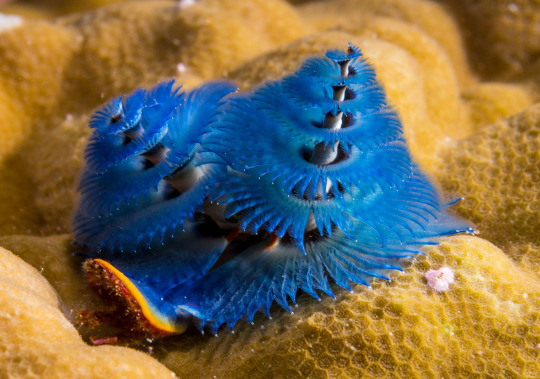
(Image: a blue-crowned Christmas tree worm emerging from yellow coral. End ID)
Christmas tree worms are found across most of the world, from the Caribbean to the Indo-Pacific, in tropical waters. They are coral reef dwellers who live in burrows built into had corals. Brain coral species are their preferred hosts, but they can live on other corals and have been reported living in sponges and on giant clams. Christmas tree worms certainly have a symbiotic relationship with the corals, it's debatable whether that relationship is parasitic, commensal, or mutualistic. They may damage nearby polyps and could spread harmful algae (that seems to be an open question), but I found sources suggesting they improve water flow around the coral, which could benefit it. When they sense a threat, the worms will rapidly retract into their tubes. Some time later (which can be seconds to minutes), they will cautiously emerge again. Worms living on crowded corals seem to be more timid, taking longer to emerge again. Christmas tree worms are broadcast spawners who release their gametes into the water. Fertilized eggs hatch quickly into larvae who must find their way to a coral and start their burrow. Christmas tree worms can live up to 30 years.
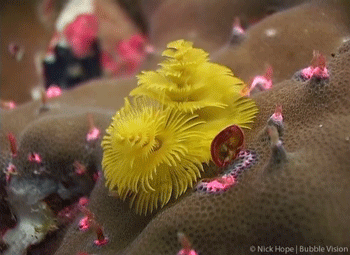
(GIF: a bright yellow Christmas tree worm retracting into its tube. The full retraction takes less than a second and leaves only a hole covered by the operculum. End ID)
Christmas tree worms are considered to have a stable population, but as they are dependent on corals, threats to reefs are threats to them. Thus, global climate change is a major threat to their survival. Predators of the worms include fish, starfish, and other worms. They are not of commercial interest to humans, but are popular among divers and have entered the aquarium trade.

(Image: multiple Christmas tree worms of various colors emerging from a coral. End ID)
#wet beast wednesday#christmas tree worm#wormblr#worms#worm#polychaete#annelid#invertebrates#invertiblr#coral reef#christmas#christmas tree#marine biology#biology#ecology#zoology#animal facts#informative#educational#image described
243 notes
·
View notes
Text
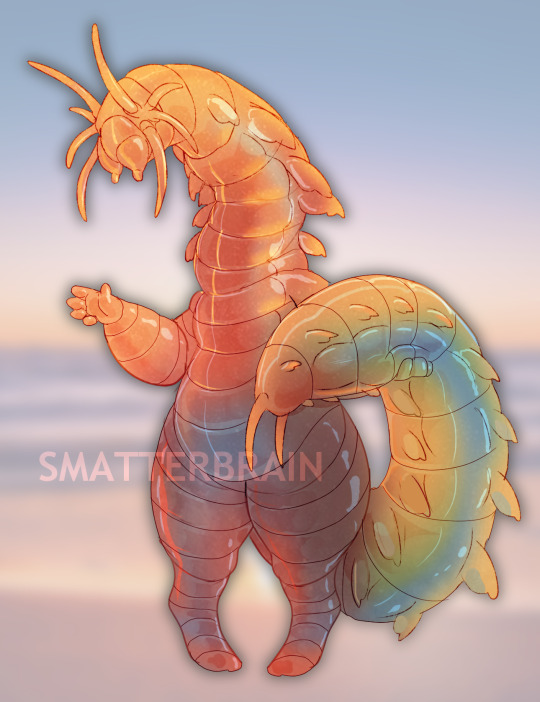
I edited my leech sketch to make a ragworm for a customer
406 notes
·
View notes
Text

By Jenny - Flickr: "Aliens" movie star!, CC BY 2.0
#bobbit worm#sand striker#trap-jaw worm#bristle worm#polychaete#annelid#just wanted to do a weird ocean worm today. weird worm wednesday on a friday#friday poll
123 notes
·
View notes
Text
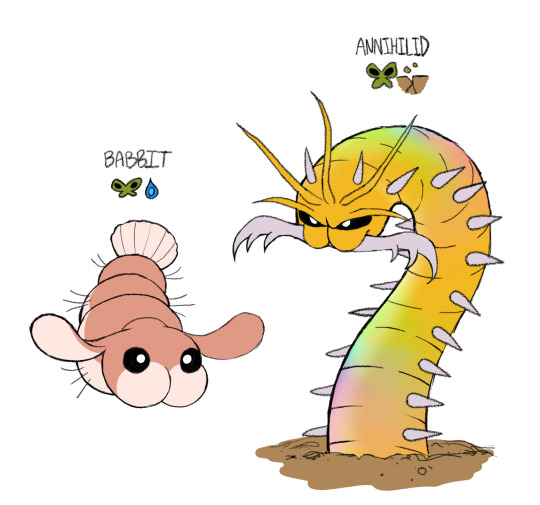

My bobbit worm Fakemon :)
Babbit is based off of the larvae and Annihilid is the adult worm!
#fakemon#pokemon#bobbit worm#Eunice aphroditois#polychaete#babbit = baby + rabbit + bobbit#annihilid = annihilate + annelid#mine
788 notes
·
View notes
Photo



Stop a Moment for the Sand Striker
Also known as the bobbit worm, Eunice aphroditois is a marine bristle worm endemic to both the Atlantic and Pacific oceans, in waters up to 95 m (311 ft) deep. Because they spend most of their time under ground, the sand striker is rarely seen. However, they can be found in both coral reefs and deeper, rocky or sandy ocean floors-- anywhere they can hide and ambush prey.
This species of bristle worm is famous for its hunting methods. Individuals live in burrows deep under ground, with an entrance covered by sand or rocks, and only emerge at night. They keep these burrows stable by secreting a mucus-like substance which coats the sandy walls and keeps them in place. Because their eyes are rudimentary at best, sand strikers use their five antennae to sense passing prey-- usually fish, but also algae or organic debris. When their target is close enough, E. aphroditois ambushes it and drags it back down into the burrow with its large mandibles. This process is extraordinarily fast; bobbit worms have been clocked moving at 6 m (20 ft) per second. The mandibles are also retractible, which helps the bobbit worm swallow its prey.
Though only their heads are usually visible, the sand striker has an impressive body. They can grow to be 1- 3 m (3-10 ft) long, although they’re typically only 25 mm (1 in) wide. Like other bristle worms, their bodies are made up of segments, protected by a hard, irridescent exoskeleton. Most sand strikers are deep purple or black, although individuals in a variety of colors have been documented. In addition to their exoskeleton, bobbit worms also sport sharp, venomous tentacles down the length of their body to deter threats. Adults are typically avoided by other, larger predators, but juveniles can be targeted by fish.
E. aphroditois lacks external reproductive organs, and instead is a broadcast spawner. When they’re ready to mate, female sand strikers produce a pheromone that attracts males and signals them to release their sperm. The females them release their eggs into the water, where they become fertilized and develop into larvae. These larvae swim freely for several months to a year, during which many become food for other animals. The survivors begin to segment and burrow into the sand, where they become sexually mature. In the wild, bobbit worms can live anywhere from 3-5 years, though some biologists believe they may have a longer lifespan of 10-15 years.
Conservation status: E. aphroditois has not been evaluated by the IUCN. However, populations in coral reefs are threatened by habitat decline.
If you like what I do, consider leaving a tip or buying me a ko-fi!
Photos
Richard Zerpe
Department of Biomedicine, University of Basel
Chutinun Mora
#bobbit worm#sand striker#Eunicida#Eunicidae#marine polychaetes#polychaete worms#bristle worms#worms#segmented worms#annelids#invertebrates#marine fauna#benthic fauna#coral reefs#atlantic ocean#Pacific Ocean#indian ocean#Indo-Pacific
155 notes
·
View notes
Text

Fanworms By: Gary G. Gibson From: The Fascinating Secrets of Oceans & Islands 1972
#fan worm#polychaete#annelid#invertebrate#1972#1970s#Gary G. Gibson#The Fascinating Secrets of Oceans & Islands
48 notes
·
View notes
Note
there's this strange sort of beast that's inspired arguments on pinterest, and I was wondering if you or your other followers could identify it. personally I am of the opinion that it is some variety of Leggéd Worm

It's marine, not a bug. I'm no sort of expert on marine life but it looks like a polychaete worm to me. No idea what species since there are thousands. The "legs" aren't used for walking but rather for swimming.
250 notes
·
View notes
Text
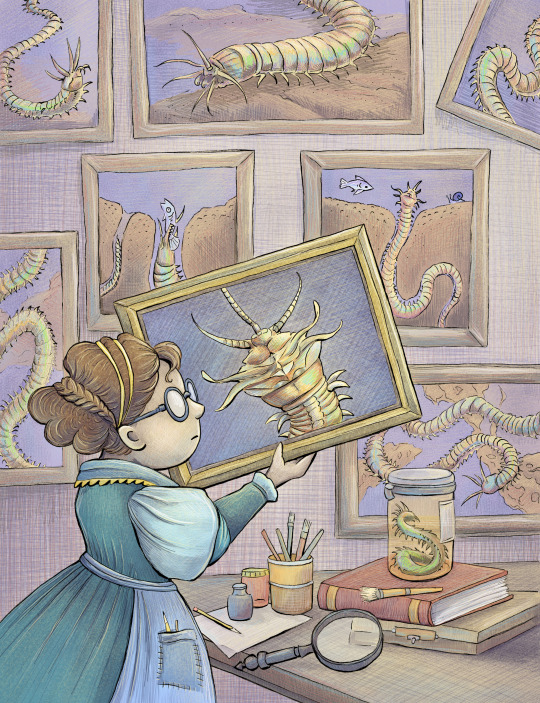
A painter preoccupied with bobbit worms.
365 notes
·
View notes
Text
Maann nobody gives a shit about bristle worms but LOOK at these fellas



What good dudes! That last guy can turn into a bear trap like this:

Bam! Now he's a bear trap!
449 notes
·
View notes